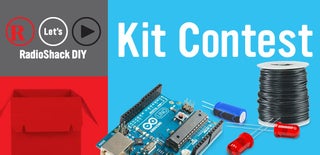Introduction: DIY Webserver With Arduino Mega 2560
In this DIY project, we will make ourself a tiny webserver with W5100 shield and arduino mega 2560,
Let's get ourself started,
Prepare all the parts....
Step 1: The Parts Needed for This DIY
1. Arduino Mega 2560
2. W5100 Ethernet shield
3. Lan cable
4. USB cable for power supply
5. Your computer
6. Arduino 1.0.4 ide
7. the code / sketch
Step 2: The Code on Arduino
Don't forget to include ethernet,spi and webserver library with it, and set your static IP if you connect directly into your computer.
/* CHANGE THIS TO YOUR OWN UNIQUE VALUE. The MAC number should be
* different from any other devices on your network or you'll have
* problems receiving packets. */
static uint8_t mac[] = { 0xDE, 0xAD, 0xBE, 0xEF, 0xFE, 0xED };
/* CHANGE THIS TO MATCH YOUR HOST NETWORK. Most home networks are in
* the 192.168.0.XXX or 192.168.1.XXX subrange. Pick an address
* that's not in use and isn't going to be automatically allocated by
* DHCP from your router. */
static uint8_t ip[] = { 192, 168, 1, 15 };
static uint8_t gateway[] = { 192, 168, 0, 1 };
static uint8_t subnet[] = { 255, 255, 255, 0 };
/* This creates an instance of the webserver. By specifying a prefix
* of "", all pages will be at the root of the server. */
#define PREFIX ""
WebServer webserver(PREFIX, 80);
/* commands are functions that get called by the webserver framework
* they can read any posted data from client, and they output to the
* server to send data back to the web browser. */
void helloCmd(WebServer &server, WebServer::ConnectionType type, char *, bool)
{
/* this line sends the standard "we're all OK" headers back to the
browser */
server.httpSuccess();
/* if we're handling a GET or POST, we can output our data here.
For a HEAD request, we just stop after outputting headers. */
if (type != WebServer::HEAD)
{
/* this defines some HTML text in read-only memory aka PROGMEM.
* This is needed to avoid having the string copied to our limited
* amount of RAM. */
P(helloMsg) = "<html><head><title>ATMEGA2560 online!!</title></head>"
"<h1>Hi Mate,this is ATMEGA2560 Calling!</h1></html>";
/* this is a special form of print that outputs from PROGMEM */
server.printP(helloMsg);
}
}
void setup()
{
/* initialize the Ethernet adapter */
Ethernet.begin(mac, ip);
/* setup our default command that will be run when the user accesses
* the root page on the server */
webserver.setDefaultCommand(&helloCmd);
/* run the same command if you try to load /index.html, a common
* default page name */
webserver.addCommand("index.html", &helloCmd);
Don't forget to include ethernet,SPI and webserver library
/* start the webserver */
webserver.begin();
}
void loop()
{
char buff[64];
int len = 64;
/* process incoming connections one at a time forever */
webserver.processConnection(buff, &len);
}
Step 3: Enjoy Yourself a Tiny Webserver With Arduino Mega 2560
I tested on IE, chrome and firefox, I'm sure you can run in any browsers you like, on linux as well...
Let's watch the video in action

Participated in the
Kit Contest

Participated in the
Pocket Sized Electronics

Participated in the
Epilog Challenge V













